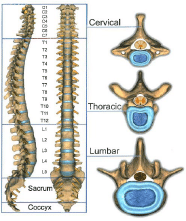
The human spine features many natural cur-vatures which help our bodies to move and be flexible. Scoliosis is a twisting of the spine. It is a condition that affects many children, teen-agers and adults.
A parent or doctor may suspect scoliosis if one shoulder appears to be higher than the other, or the pelvis appears to be tilted. Untrained observers often do not notice the curving in the earlier stages. Children’s modesty causes them not to undress in front of their parents. When they are in a bathing suit, do you notice a side-ways curvature of the spine that looks like an “S” or “C” or that one shoulder or hip appears higher than the other?

The doctor will ask your child to bend forward, to reveal any rotational deformities. This is called the “Adam’s forward bend test.” He or she will also check for any limb-length discrep-ancies, abnormal neurological findings, or oth-er potential causes of scoliosis.
The cause for scoliosis is unknown, but it does seem to be genetic and can run in some families. It also progresses during puberty. Of every one thousand children, three to five will develop spinal curves that are considered significant enough to need treatment.
In order to understand scoliosis, it helps to understand your spine and how it works.
Your spine is made up of small bones, called vertebrae, which are stacked on top of one another. Muscles, ligaments, nerves, and intervetrebal disks are additional parts of your spine.

These bones connect to create a canal that protects the spinal cord. The spinal column is made up of three sections that create three natural curves in your back: the curves of the neck area (cervical), chest area (thoracic), and lower back (lumbar). The lower section of your spine (sacrum and coccyx) is made up of ver-tebrae that are fused together. Five lumbar vertebrae connect the twelve thoracic vertebra to the pelvis.
Each child is different, and your physician will suggest the best treatment option for the child. These include:
Continually observing a small curve to check for progression as the child or adolescent grows.

Advances in orthotics and prosthetics have led to much more comfortable and lighter weight polypropylene plastic. Besides the foam-lined, body jacket-type TLSO of the Boston type, nighttime only Providence Braces have been shown to be just as effective for certain patterns of scoliosis. Investigation continues to determine the effectiveness of these newer braces in preventing progression of scoliosis. Unfortunately, to date, no brace has been shown to actually improve scoliosis. That desired outcome is only available via surgical treatment.
The surgical treatment of idiopathic scoliosis is usually reserved for curves that have progressed beyond 40 to 45 degrees. If left untreated, con-tinued progression of these curves may lead to chronic severe pain, deformity, psychosocial dis-ability and pulmonary dysfunction.

Idiopathic scoliosis, in which the cause is un-known, affects approximately 2% of the popula-tion, although only a small number of those with scoliosis require treatment. Treatment of scoliosis is indicated for those who have pro-gressive spinal deformity.